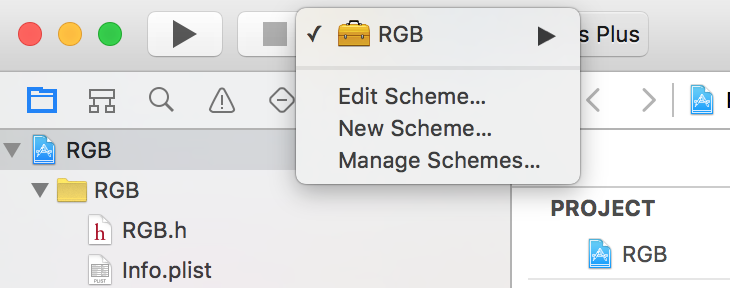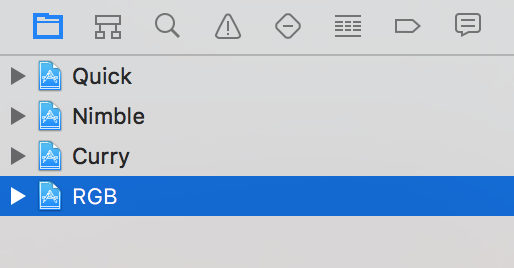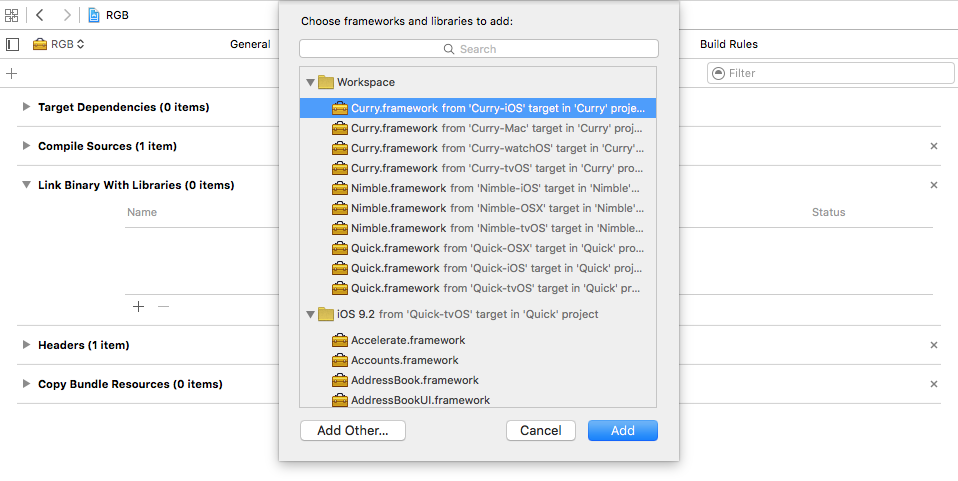Creating your first iOS Framework
转自:https://robots.thoughtbot.com/creating-your-first-ios-framework
If you’ve ever tried to create your own iOS framework, you know that it’s not for the faint of heart – managing dependencies and writing tests doesn’t make it any easier. This tutorial will walk you through creating your first iOS framework from start to finish so that you can go out and create your own.
We’re going to build a framework that exposes a function calledRGBUIColor(red:green:blue) that returns a new UIColor created from those values. We’ll build it using Swift, with Carthage as our dependency manager. Our framework will be consumable using Carthage, CocoaPods, or git submodules.
Let’s begin!
Setting up the Xcode Project
- Select File → New → Project.
- Select iOS → Framework & Library from the left sidebar and select “Cocoa Touch Library” on the right.
- Click “Next” and fill in the option prompts. Make sure to select the “Include Unit Tests” check box.

- Select where you’d like to save your project.
- Uncheck “Create Git repository on My Mac”, we’ll manually set it up later.
- Click “Create” and the project will open in Xcode.
- Go to File → Save As Workspace and save it in the same directory as your Xcode project with the same name. We put the project in a workspace because we’ll be adding our Carthage dependencies as submodules; they must be in a workspace for Xcode to build them.
- Close the Xcode project with File → Close Project.
- Open the workspace with File → Open.
- Click on the scheme on the top left of Xcode and select “Manage Schemes”. We need to mark our scheme as “shared” so that the project can be built with Carthage.
- Locate the “RGB” scheme and check the “Shared” check box and click “Close”.

Let’s jump over to the terminal.
Initializing Git
First, navigate to the directory you saved your project in.
- Run
git initto initialize an empty repository. - Create a
.gitignorewhich will keep out some pesky Xcode and dependency files we don’t want to track in git.
Here’s a standard one for Swift projects with a few modifications. We added .DS_Storeand removed fastlane and extra comments.
## OS X Finder
.DS_Store
## Build generated
build/
DerivedData
## Various settings
*.pbxuser
!default.pbxuser
*.mode1v3
!default.mode1v3
*.mode2v3
!default.mode2v3
*.perspectivev3
!default.perspectivev3
xcuserdata
## Other
*.xccheckout
*.moved-aside
*.xcuserstate
*.xcscmblueprint
## Obj-C/Swift specific
*.hmap
*.ipa
# Swift Package Manager
.build/
# Carthage
Carthage/Build
Adding Carthage and Dependencies
- Create a file in your project directory named
Cartfileand the runtime dependencies to it. We’ll add Curry.
github "thoughtbot/Curry"
- Create a
Cartfile.private. It will house private dependencies like our test frameworks. We’ll use Quick and Nimble.
github "Quick/Quick"
github "Quick/Nimble"
- Create a
bin/setupscript. It’s used to give our contributors (and us) a simple way to set up the project and the dependencies.
mkdir bin
touch bin/setup
chmod +x bin/setup
- Open up
bin/setupand fill it with:
#!/usr/bin/env sh
if ! command -v carthage > /dev/null; then
printf 'Carthage is not installed.\n'
printf 'See https://github.com/Carthage/Carthage for install instructions.\n'
exit 1
fi
carthage update --platform iOS --use-submodules --no-use-binaries
In this script, we make sure the user has Carthage installed and run its update command to install the iOS dependencies.
We’re using --use-submodules so that our dependencies are added as submodules. This allows users to consume our framework outside of Carthage if they want. We use--no-use-binaries so that our dependencies are built on our system.
With bin/setup created, let’s run it so that Carthage will download our dependencies.
- In the terminal, run
bin/setup.
Now we need to set up our project to build and link the new dependencies.
Adding Dependencies to the Workspace
Since our dependencies are submodules, we need to add them to our workspace.
- Open up
Carthage/Checkoutsand add each dependency’s.xcodeprojto the root of the workspace. They can be dragged from Finder into the navigator of the Xcode project.
When you’re done it should look like:

Link Runtime Dependencies
- With “RGB” selected in the Navigator and the “RGB” target selected on the middle sidebar, select the “Build Phases” tab and expand the “Link binary with libraries” section.
- Click the “+” icon and select the
Curry.frameworkfrom theCurry-iOStarget. - Click “Add”.

Link Development Dependencies
- Select the “RGBTests” target from the middle sidebar.
- Using the same process as before, add the Quick and Nimble frameworks to the “Link binary with libraries” section for this target.
When adding dependencies to each target, Xcode will automatically add them to the “Framework Search Paths” under the “Build Settings” tab. We can remove these from the “RGB” and “RGBTests” target because Xcode treats them as implicit dependencies due to them being in the same workspace.
- Select the target, locate the “Framework Search Paths” setting, highlight it, and press “backspace” on your keyboard.

- Next, look in the “RGB” project in the Navigator; you’ll see there are three new frameworks at the root level. To keep this area organized, highlight all three, right click and select “New group from selection” to place them in a named group. I’ll call mine “Frameworks”.
Now that Carthage is set up, let’s add CocoaPods.
Adding CocoaPods support
To add CocoaPods support, we need to create a .podspec at the root of our project and fill in our project info.
- Create a file named
RGB.podspec. - Copy and paste the sample below into the file.
- Fill in the options with your project’s details. There are a lot more options available to you, but these are what’s needed for this project.
Pod::Spec.new do |spec|
spec.name = "RGB"
spec.version = "1.0.0"
spec.summary = "Sample framework from blog post, not for real world use."
spec.homepage = "https://github.com/jakecraige/RGB"
spec.license = { type: 'MIT', file: 'LICENSE' }
spec.authors = { "Your Name" => 'your-email@example.com' }
spec.social_media_url = "http://twitter.com/thoughtbot"
spec.platform = :ios, "9.1"
spec.requires_arc = true
spec.source = { git: "https://github.com/jakecraige/RGB.git", tag: "v#{spec.version}", submodules: true }
spec.source_files = "RGB/**/*.{h,swift}"
spec.dependency "Curry", "~> 1.4.0"
end
One line to pay attention to is spec.dependency "Curry", '~> 1.4.0'. Because we’re supporting CocoaPods, we expect the consumers of our framework to be using it instead of Carthage, so we have to specify dependencies here and in the Cartfile.
Once this is set up we can run the pod lib lint command to test that everything is configured properly. If all goes well, we’ll see something like this:

With the project and dependencies set up, we’re almost ready to write some code. Before we do that, let’s create our first commit.
git commit -am "Project and dependencies set up"
Writing the First Test
Open RGBTests/RGBTests.swift so that we can take a look at the default template. It uses @testable and XCTest, but we’ll be changing both of these.
We’ll remove @testable because we want to test the public API that consumers of the framework will use. As our framework grows, we may need @testable to test parts that are not exposed publicly; generally we want to avoid that so we are testing what’s exposed to the consumer. This feature is most useful in testing applications rather than frameworks.
From the Apple Docs on Testability:
With testability, you are now able to write tests of Swift 2.0 frameworks and apps without having to make all of your internal routines public. Use @testable import {ModuleName} in your test source code to make all public and internal routines usable by XCTest targets, but not by other framework and app targets.
We’ll use Quick and Nimble for testing. Quick provides a nicer testing interface with a behavior-driven style that is very similar to RSpec and Specta; Nimble gives us many powerful assertions and the ability to write asynchronous code with less boilerplate.
Once those changes are made, the test file should look like:
import Quick
import Nimble
import RGB
class RGBTests: QuickSpec {
override func spec() {
describe("RGB") {
it("works") {
expect(true).to(beTrue())
}
}
}
}
Run the tests with ⌘U or Product → Test and they should be green.
And… we’re done!

Just kidding. Let’s write some real tests.
We expect that calling RGBUIColor(red: 195, green: 47, blue: 52) will return a beautiful “thoughtbot red” UIColor.
In code, this looks like:
describe("RGBUIColor") {
it("is a correct representation of the values") {
let thoughtbotRed = UIColor(
red: CGFloat(195/255),
green: CGFloat(47/255),
blue: CGFloat(52/255),
alpha: 1
)
let color = RGBUIColor(red: 195, green: 47, blue: 52)
expect(color).to(equal(thoughtbotRed))
}
}
If we run the tests, now they will fail as we expect. Swift’s type checking will prevent us from running the tests because we never defined the RGBUIColor function.
Let’s do that.
Writing the Implementation
Right click on the “RGB” group in the Navigator and select “New File”.
Create a Swift file called RGBUIColor.swift and save it. Fill it with this implementation:
import Curry
func RGBUIColor(red red: Int, green: Int, blue: Int) -> UIColor {
return curry(createColor)(red)(green)(blue)
}
private func createColor(red: Int, green: Int, blue: Int) -> UIColor {
return UIColor(
red: CGFloat(red/255),
green: CGFloat(green/255),
blue: CGFloat(blue/155),
alpha: 1
)
}
The use of curry here is used as an example of using a runtime dependency. This is a non-standard use and doesn’t provide any value here.
Now let’s run the tests!

At first glance, this error may seem a bit odd. We clearly defined the RGBUIColorfunction, right?
We did, but it’s not marked as public.
What this means is that if someone tries to use our framework, they won’t be able to see this function. If you want to see the difference in action, add @testable back and your tests will pass.
Experiencing this error is why we removed the @testable from the import at the beginning. It helps us to catch these kinds of errors earlier, before we release our framework to others.
To fix this, let’s mark the function as public like so:
public func RGBUIColor(red red: Int, green: Int, blue: Int) -> UIColor {
return curry(createColor)(red)(green)(blue)
}
Let’s run the tests!

We’re Green!
Let’s commit this bad boy.
git commit -am "Completed my first iOS framework!"
That’s all folks!
That’s it. There were a lot of steps but we’ve successfully created a marginally usefulframework that could be published to GitHub. As a matter of fact, we published thesource for this framework on GitHub.
We can’t wait to see what kinds of awesome open-source projects you’ll create.
Creating your first iOS Framework的更多相关文章
- [Cordova] Plugin里使用iOS Framework
[Cordova] Plugin里使用iOS Framework 前言 开发Cordova Plugin的时候,在Native Code里使用第三方Library,除了可以加速项目的时程.也避免了重复 ...
- ios framework 分离与合并多种CPU架构,分离与合并模拟器与真机
ios framework 分离与合并多种CPU架构,分离与合并模拟器与真机 如果你所用的framework支持真机和模拟器多种CPU架构,而你需要的是其中的一种或几种,那么可以可以从framewo ...
- ios framework 开发实战 之 参考
WWDC2014之iOS使用动态库 iOS开发——创建你自己的Framework 使用CocoaPods开发并打包静态库 iOS Framework 和CocoaPods TDD的iOS开发初步以及K ...
- ios framework 开发
ios framework 开发 之 参考 ios framework 开发 之 实战 iOS workspace 依次编译多个工程
- (转载)iOS Framework: Introducing MKNetworkKit
This article is available in Serbo-Croatian, Japanese and German. (Translations in Serbo-Croatian b ...
- iOS framework
(一),lipo 命令 1)合并文件: lipo -create xxxX/liblibsql.a xxxx/liblibsql.a -output libsql.a 2)查看Framework 对C ...
- ios framework通用库的制作
这篇文章是在史上最完整的iOS DIY framework 详细教程(一)的基础上加以修改 1.新建一个静态库工程: 2:取自己喜欢的名字: 3.删除向导所生成工程中的 Target: 3.删除Tes ...
- ios framework 开发 之 实战二 ,成功
1. 新建工程.引入cocoapod略过不提 2. 更改cocoapod类名 这是因为,引用framework的工程中,也有一个同样的文件,及文件里同样的类. 这个文件不能删除,但是可以重命名. 3. ...
- ios framework 开发 之 实战 一,合并失败了
保证public 文件目录独立 在 XCode 7 中,这一条已经自动实现了 Build Settings>Public Headers Folder Path "$(PROJECT_ ...
随机推荐
- Http帮助类(史上最详细帮助类)
分享一波干活,HttpHelper(支持设置获取Cookie和设置SSL证书) 代码 /// <summary> /// Http连接操作帮助类 /// </summar ...
- 数据分析之路 第一篇 numpy
第一篇 numpy 1.N维数组对象 :ndarray在Python中既然有了列表类型,为啥还要整个数组对象(类型)?那是因为:1.数组对象可以除去元素间运算所需要的循环,使得一维向量更像单个数据2. ...
- R画图——分屏
最近项目需求,用R画了一个九宫格的图,第一次画,将简化后的脚本呈现一下,不是有人说,既然做了,那就摆出来吧. *中文行为说明: args <- commandArgs(T) 调用命令行读取 fi ...
- C++图像加Lidar点云转写rosbag
近期需要处理一批Lidar+image的数据,拿到的是其他格式,但要转存成rosbag使用,参考部分网上做法,完成并记录. 1.Lidar处理 主要是将Lidar点云信息按点转为pcl::PointX ...
- SpringBoot系列教程JPA之指定id保存
原文链接: 191119-SpringBoot系列教程JPA之指定id保存 前几天有位小伙伴问了一个很有意思的问题,使用 JPA 保存数据时,即便我指定了主键 id,但是新插入的数据主键却是 mysq ...
- 🔥「课代表」帮你总结了全网最全的Redis知识点
你知道的越多,你不知道的越多 点赞再看,养成习惯 GitHub上已经开源 https://github.com/JavaFamily 有一线大厂面试点脑图.个人联系方式和人才交流群,欢迎Star和指教 ...
- 在C\C++中char 、short 、int各占多少个字节
在C\C++中char .short .int各占多少个字节 : #include <bits/stdc++.h> using namespace std; int main() { co ...
- 利用 pyhon 解决 Cross Origin Requests
在学习 ajax 时遇到了一个问题 XMLHttpRequest cannot load file:xxxxxxxx . Cross origin requests are only supporte ...
- linux网络测试命令
一.ping 它通过向目标主机发送一个个数据包以及接受数据包的回应来判断主机和目标主机之间网络连接情况.ping的两个功能:判断网络是否可达.网络性能统计. ping使用的是网络层的ICMP协议. p ...
- 机器学习 TensorFlow 实现智能鉴黄
前言 最近在做一款图床服务,关注公号的小伙伴一定记得小柒曾说过,会在周末放出的,不好意思放大家鸽子了.之所以一直没敢放出,是因为鉴黄接口一直没调试好,虽然我对公号的小伙伴百分之百信任,奈何互联网鱼龙混 ...
